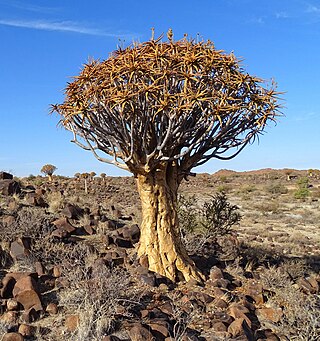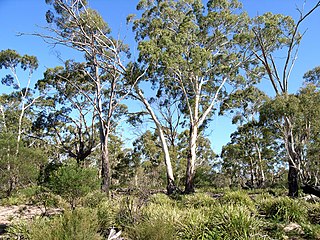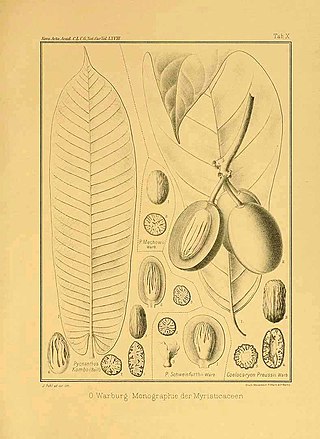
Schinopsis balansae is a hardwood tree known as willow-leaf red quebracho which forms forests in the subtropical Humid Chaco ecoregion of north-eastern Argentina, and Paraguay. It is also found in the wild Pantanal vegetation in Brazil. Some of its vernacular names are quebracho colorado chaqueño and quebracho santafesino. Other species, like Schinopsis lorentzii, bear the general name quebracho and have similar properties and uses. S. balansae shares its habitat with a species of the same genus, S. heterophylla, and the two are often confused.

Aloidendron dichotomum, formerly Aloe dichotoma, the quiver tree or kokerboom, is a tall, branching species of succulent plant, indigenous to Southern Africa, specifically in the Northern Cape province of South Africa, and parts of Southern Namibia.

Eucalyptus viminalis, commonly known as the manna gum, white gum or ribbon gum, is a species of small to very tall tree that is endemic to south-eastern Australia. It has smooth bark, sometimes with rough bark near the base, lance-shaped to curved adult leaves, flower buds in groups of three or seven, white flowers and cup-shaped or hemispherical fruit.

The genus of the myrrhs, Commiphora, is the most species-rich genus of flowering plants in the frankincense and myrrh family, Burseraceae. The genus contains approximately 190 species of shrubs and trees, which are distributed throughout the (sub-) tropical regions of Africa, the western Indian Ocean islands, the Arabian Peninsula, India, and South America. The genus is drought-tolerant and common throughout the xerophytic scrub, seasonally dry tropical forests, and woodlands of these regions.
Corkwood is a common name of a number of plants:

Pterocarpus angolensis is a species of Pterocarpus native to southern Africa, in Angola, Mozambique, Namibia, South Africa, Eswatini, Tanzania, Democratic Republic of the Congo, Zimbabwe, and Zambia. It is a protected tree in South Africa. The name Kiaat, although Afrikaans, is sometimes used outside South Africa as well. In Zimbabwe, depending on what region you are in, it is known as Mukwa or Mubvamaropa.

Commiphora wightii, with common names Indian bdellium-tree, gugal, guggul, gugul, or mukul myrrh tree, is a flowering plant in the family Burseraceae, which produces a fragrant resin called gugal, guggul or gugul, that is used in incense and vedic medicine. The species is native to southern Pakistan and western India. It prefers arid and semi-arid climates and is tolerant of poor soil.

Combretum padoides, the thicket bushwillow, occurs in the lowlands of tropical and south-eastern Africa. They grow in a range of habitats from muddy riverbanks to dry rocky hillsides. The mostly opposite oval leaves are carried on long slender branches. The trees or shrubs flower in profusion in mid-summer and the 4-winged fruits reach maturity from late summer to mid winter.

Allanblackia stuhlmannii is a species of flowering plant in the family Clusiaceae. It is found only in Tanzania.

Kirkia is a genus of plant in family Kirkiaceae. It was previously placed in family Simaroubaceae, but was transferred into Kirkiaceae, together with Pleiokirkia, because these genera produce neither quassinoids nor limonoids.

Buchanania obovata is a small to medium-sized understorey tree in woodlands native to northern Australia, in particular in Arnhem Land in the Northern Territory. Common names include green plum and wild mango.

Petunidin (Pt), like Europinidin and Malvidin, is derived from Delphinidin and is an O-methylated anthocyanidin of the 3-hydroxy type. It is a natural organic compound, a dark-red or purple water-soluble pigment found in many redberries including chokeberries, Saskatoon berries or different species of grape, and also part of the pigments responsible for the petal colors in many flowers. This pigment gives the Indigo Rose tomatoes the majority of their deep purple color when the fruits are exposed to sunlight. The name of the molecule itself is derived from the word Petunia.

Bursera fagaroides is a species of flowering plant in the genus Bursera known by the common names torchwood copal and fragrant bursera. It is widespread across much of Mexico from Sonora to Oaxaca, and its range extends just into Arizona in the United States, although some sources suggest that it may now be extirpated in Arizona.

Pycnanthus angolensis is a species of tree in the nutmeg family, Myristicaceae. It is native to Tropical Africa. Its English language common names include African nutmeg, false nutmeg, boxboard, and cardboard. In Africa it is widely known as ilomba.
Commiphora africana, commonly called African myrrh, is a small deciduous tree belonging to the Burseraceae, a family akin to the Anacardiaceae, occurring widely over sub-Saharan Africa in Angola, Botswana, Burkina Faso, Chad, Eswatini, Eritrea, Ethiopia, Kenya, Mali, Mauritania, Mozambique, Namibia, Niger, Senegal, Somalia, South Africa, Sudan, Tanzania, Uganda, Zambia and Zimbabwe. On sandy soils this species sometimes forms pure stands, deserving consideration as a plant community or association.

Maerua angolensis is a 10m tall, occasionally deciduous tree of the Capparaceae or caper family, often growing on termitaria and in thickets fringing seasonal watercourses, up to 1800m. Though never common, it is widespread in tropical Africa and arid regions, being absent from high-rainfall regions.
Dacryodes incurvata is a tree in the family Burseraceae. The specific epithet incurvata is from the Latin meaning "bending inward", referring to the leaflet margin.

The Angolan giraffe, also known as the Namibian giraffe or smokey giraffe, is a species or subspecies of giraffe that is found in northern Namibia, south-western Zambia, Botswana, and western Zimbabwe.

Alstonia congensis, is a tree within the Apocynaceae family and one of two African species within the Alstonia genus, the other being the Alstonia boonei De Wild. Both have similar morphological characteristics.
















